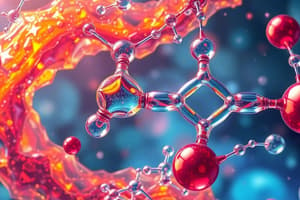Podcast
Questions and Answers
What are the main products of ozonolysis?
What are the main products of ozonolysis?
Aldehydes and ketones
Describe the mechanism of ozonolysis involving the ozone molecule.
Describe the mechanism of ozonolysis involving the ozone molecule.
The ozone molecule reacts with the alkene double bond to form a peroxy radical and an alkyl radical as initial products.
What is the application of ozonolysis in organic chemistry?
What is the application of ozonolysis in organic chemistry?
Synthesis of organic compounds
What happens during the 'ozonolysis step' in the mechanism?
What happens during the 'ozonolysis step' in the mechanism?
What is the importance of ozonolysis in the identification of structures?
What is the importance of ozonolysis in the identification of structures?
What are the main products formed during ozonolysis of alkene molecules?
What are the main products formed during ozonolysis of alkene molecules?
Explain the role of reducing agents in ozonolysis.
Explain the role of reducing agents in ozonolysis.
How is ozonolysis used in the identification of structures and stereochemistry?
How is ozonolysis used in the identification of structures and stereochemistry?
What role does ozone play in ozonolysis?
What role does ozone play in ozonolysis?
Discuss the importance of ozonolysis in organic chemistry.
Discuss the importance of ozonolysis in organic chemistry.
Flashcards are hidden until you start studying
Study Notes
Ozonolysis
Ozonolysis is a chemical reaction that involves the decomposition of alkene molecules using ozone (O3). This process is widely used in organic chemistry and has various applications, including the synthesis of organic compounds, the identification of structures and stereochemistry, and the analysis of environmental pollutants. In this article, we will discuss the products, mechanism, applications, reagents, and importance of ozonolysis.
Products
The main products of ozonolysis are aldehydes and ketones, which are formed by the cleavage of the C=C double bond in alkenes. The ozone molecule adds to the double bond, forming a peroxy radical, which then reacts with another alkene molecule to initiate a chain reaction. This leads to the formation of various aldehydes and ketones, depending on the functional groups present in the alkene.
Mechanism
The mechanism of ozonolysis involves the following steps:
- The ozone molecule (O3) reacts with the alkene double bond, forming a peroxy radical (O3-O-R) and an alkyl radical (R•) as the initial products.
- The peroxy radical undergoes a rapid reaction with another molecule of ozone, leading to the formation of an acylperoxy radical (O3-O-C=O). This reaction is also known as the "ozonolysis step."
- The acylperoxy radical then decomposes into an alkene and an aldehyde (or ketone), releasing an oxygen molecule (O2).
Applications
Ozonolysis has several applications in organic chemistry, including:
- Synthesis of Organic Compounds: Ozonolysis is used to synthesize various organic compounds by cleaving double bonds and forming aldehydes or ketones. These products can then be further functionalized or used as building blocks for the synthesis of more complex molecules.
- Identification of Structures and Stereochemistry: Ozonolysis is a valuable tool for determining the structure and stereochemistry of alkene molecules. By analyzing the products formed during ozonolysis, chemists can identify the presence of specific functional groups and their relative configurations.
- Analysis of Environmental Pollutants: Ozonolysis is used in the analysis of environmental pollutants, such as polycyclic aromatic hydrocarbons (PAHs), by cleaving their double bonds and forming aldehydes or ketones. These products can then be detected and quantified using various analytical techniques.
Reagents
In ozonolysis, the main reagent is ozone (O3), which is typically generated in situ by passing oxygen (O2) through an ozone generator. Other reagents used in the process include alkene substrates, which provide the starting material for the reaction, and various reducing agents, such as hydrogen (H2), to reduce the peroxy radicals formed during ozonolysis.
Importance
Ozonolysis is an important tool in organic chemistry due to its versatility and wide range of applications. It provides a valuable method for the synthesis of organic compounds, the identification of structures and stereochemistry, and the analysis of environmental pollutants. Additionally, ozonolysis is a clean and environmentally friendly process that does not produce hazardous byproducts, making it an attractive alternative to other chemical reactions.
Studying That Suits You
Use AI to generate personalized quizzes and flashcards to suit your learning preferences.




